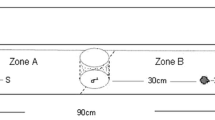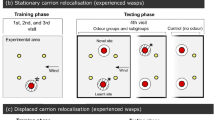Abstract
Worldwide, predators and humans are in conflict for resources such as game species or livestock, especially in the case of wild canids. One non-lethal method to reduce predation is conditioned food aversion (CFA), in which animals learn to avoid a food due to the illness after ingestion, caused by the addition of an undetected chemical compound. CFA can be enhanced by adding an artificial odour cue, in a process known as taste-potentiated odour aversion (TPOA). We tested CFA and TPOA with three experimental groups of penned dogs. Food was offered with a combination of microencapsulated levamisole + vanilla odour (ODO), microencapsulated levamisole (LEV), or plain food as a control. The aims were (a) to test whether dogs detected the microencapsulated levamisole, (b) to analyse the strength and extinction time of CFA induced by microencapsulated levamisole, and (c) to analyse the strength and extinction time of TPOA. Two-choice tests were carried out during 11 post-conditioning months, and two reinforcements with microencapsulated levamisole were performed during the first post-conditioning month. In the first post-conditioning test, ODO and LEV groups ate significantly less untreated food than control group. After reinforcement, the dogs in LEV group resumed eating the food. Three of four dogs in ODO group showed long-lasting CFA until the 11th month. These results show that TPOA could be used to induce odour aversion on canids and that the odour cue overshadows the slight bitter taste of microencapsulated levamisole. These results show TPOA as a promising tool to reduce predation by wild canids.


Similar content being viewed by others
References
Amrutkar PP, Patil SB, Todarwa AN, Wagh MA, Kothawade PD, Surawase RK (2010) Design and evaluation of taste masked chewable dispersible tablet of lamotrigine by melt granulation. Int J Drug Deliv 2:183–191
Baker SE, Johnson PJ, Slater D, Watkins RW, Macdonald DW (2007) Learned food aversion with and without an odour cue for protecting untreated baits from wild mammal foraging. Appl Anim Behav Sci 102:410–428
Baker SE, Ellwood SA, Slater D, Watkins RW, Macdonald DW (2008) Food aversion plus odor cue protects crop from wild mammals. J Wildl Manag 72:785–791
Batsell WR, Paschall GY (2009) Mechanisms of compound conditioning in flavor-aversion conditioning. In: Reilly S, Schachtman TR (eds) Conditioned taste aversion: behavioral and neural processes. Oxford University Press, Oxford, pp 159–178
Bergstrom BJ (2017) Carnivore conservation: shifting the paradigm from control to coexistence. J Mammal 98:1–6
Beschta RL, Ripple WJ (2009) Large predators and trophic cascades in terrestrial ecosystems of the western United States. Biol Conserv 142:2401–2414
Bouton ME, Jones DL, McPhillips SA, Swartzentruber D (1986) Potentiation and overshadowing in odor-aversion learning: role of method of odor presentation, the distal–proximal cue distinction, and the conditionability of odor. Learn Motiv 17:115–138
Cagnacci F, Massei G, Cowan DP, Delahay RJ (2005) Can learned aversion be used to control bait uptake by Eurasian badgers? Appl Anim Behav Sci 92:159–168
Conover MR (1989) Potential compounds for establishing conditioned food aversions in raccoons. Wildl Soc Bull 17:430–435
Cowan DP, Reynolds JC, Gill EL (2000) Reducing predation through conditioned taste aversion. In: Gosling LM, Sutherland WJ (eds) Behaviour and conservation. Cambridge University Press, New York, pp 281–299
Din JU, Ali H, Ali A, Younus M, Mehmood T, Norma-Rashid Y, Nawaz MA (2017) Pastoralist-predator interaction at the roof of the world: conflict dynamics and implications for conservation. Ecol Soc 22:32
Durlach PJ, Rescorla RA (1980) Potentiation rather than overshadowing in flavor-aversion learning: an analysis in terms of within-compound associations. J Exp Psychol Anim Behav Process 6:175–187
Ellins SR, Catalano SM, Schechinger SA (1977) Conditioned taste aversion: a field application to coyote predation on sheep. Behav Biol 20:91–95
European Commission (2007) Commission recommendation of 18 June 2007 on guidelines for the accommodation and care of animals used for experimental and other scientific purposes. Off J Eur Union L197:1–89
Garcia J, Kimeldorf DJ (1957) The temporal relationship within the conditioning of a saccharin aversion through radiation exposure. J Comp Physiol Psychol 50:180–183
Garcia J, Hankins WG, Robinson JH, Vogt JL (1972) Bait shyness: tests of CS-US mediation. Physiol Behav 8:807–810
Garcia J, Hankins WG, Rusiniak K (1974) Behavioral regulation of the milieu interne in man and rat. Science 185:824–831
Gentle M, Massei G, Saunders G (2004) Levamisole can reduce bait monopolization in wild red foxes Vulpes vulpes. Mammal Rev 34:325–330
Gill EL, Whiterow A, Cowan DP (2000) A comparative assessment of potential conditioned taste aversion agents for vertebrate management. Appl Anim Behav Sci 67:229–240
Gokce HI, Gunes V, ERrdogan HM, Citil M, Akca A, Yuksek N (2004) The effects of levamisole poisoning on the haematological and biochemical parameters in dogs. Dtsch tierärztl Wschr 111:81–85
Gustavson CR, Garcia J, Hankins WG, Rusiniak KW (1974) Coyote predation control by aversive conditioning. Science 184:581–583
Gustavson CR, Kelly DJ, Sweeney M, Garcia J (1976) Prey-lithium aversions. I: coyotes and wolves. Behav Biol 17:61–72
Hamdani J, Moës AJ, Amighi K (2003) Physical and thermal characterisation of Precirol® and Compritol® as lipophilic glycerides used for the preparation of controlled-release matrix pellets. Int J Pharm 260:47–57
Jelinski DE, Rounds RC, Jowsey JR (1983) Coyote predation on sheep, and control by aversive conditioning in Saskatchewan. J Range Manag 36:16–19
Kalat JW, Rozin P (1973) Learned safety as a mechanism in long-delay taste-aversion learning in rats. J Comp Physiol Psychol 83:198–207
Lindstrom MJ, Bates DM (1988) Newton-Raphson and EM algorithms for linear mixed effects models for repeated–measures data. J Am Stat Assoc 83:1014–1022
Macdonald DW, Sillero-Zubiri C (2004) The biology and conservation of wild canids. Oxford University Press, Oxford
Mašić I, Ilić I, Ibrić S, Parojčić J, Đurić Z (2012) An investigation into the effect of formulation variables and process parameters on characteristics of granules obtained by in situ fluidized hot melt granulation. Int J Pharm 423:202–212
Massei G, Cowan DP (2002) Strength and persistence of conditioned taste aversion agents in rats: evaluation of eleven potential compounds. Appl Anim Behav Sci 75:249–260
Massei G, Lyon AJ, Cowan DP (2003a) Levamisole can induce conditioned taste aversion in foxes. Wildl Res 30:633–637
Massei G, Lyon AJ, Cowan DP (2003b) Potential compounds for inducing conditioned taste aversion in ferrets. N Z J Zool 30:95–100
Mikulka PJ, Klein SB (1977) The effect of CS familiarization and extinction procedure on the resistance to extinction of a taste aversion. Behav Biol 19:518–522
Nicolaus LK, Nellis DW (1987) The first evaluation of the use of conditioned taste aversion to control predation by mongooses upon eggs. Appl Anim Behav Sci 17:329–346
Nicolaus LK, Farmer PV, Gustavson CR, Gustavson JC (1989) The potential of estrogen-based conditioned aversion in controlling depredation: a step closer toward the “magic bullet”. Appl Anim Behav Sci 23:1–14
Nielsen S, Travaini A, Vassallo AI, Procopio D, Zapata SC (2015) Conditioned taste aversion in the grey fox (Pseudalopex griseus), in Southern Argentine Patagonia. Appl Anim Behav Sci 163:167–174
Norbury G, O’Connor C, Byrom A (2005) Conditioned food aversion to eggs in captive-reared ferrets, Mustela furo: a test of seven potential compounds. Appl Anim Behav Sci 93:111–121
R Core Team (2017) R: a language and environment for statistical computing. R Foundation for Statistical Computing. R Foundation for Statistical Computing, Vienna, Austria http://www.r-projectorg/. Accessed 22 May 2018
Ray JC, Hunter L, Zigouris J (2005) Setting conservation and research priorities for larger African carnivores. WCS Working Paper No. 24. Wildlife Conservation Society, New York
Rescorla RA, Wagne AR (1972) A theory of Pavlovian conditioning: variations in the effectiveness of reinforcement and nonreinforcement. In: Black AH, Prokasy WF (eds) Classical conditioning II: current research and theories. Appleton-Century-Crofts, New York, pp 64–99
Revusky SH, Bedarf EW (1967) Association of illness with prior ingestion of novel foods. Science 155:219–220
Reynolds JC, Tapper SC (1996) Control of mammalian predators in game management and conservation. Mammal Rev 26:127–155
Riley AL, Tuck DL (1985) Conditioned food aversions: a bibliography. Ann N Y Acad Sci 443:381–437
Ripple WJ, Estes JA, Beschta RL, Wilmers CC, Ritchie EG, Hebblewhite M, Berger J, Elmhagen B, Letni M, Nelson MP, Schmitz OJ, Smith DW, Wallach AD, Wirsin AJ (2014) Status and ecological effects of the world’s largest carnivores. Science 343:1241484
Rusiniak KW, Hankins WG, Garcia J, Brett LP (1979) Flavor–illness aversions: potentiation of odor by taste in rats. Behav Neural Biol 25:1–17
Sánchez-Barbudo IS, Camarero PR, Mateo R (2012) Primary and secondary poisoning by anticoagulant rodenticides of non-target animals in Spain. Sci Total Environ 420:280–288
Shukla D, Chakraborty S, Singh S, Mishra B (2011) Lipid-based oral multiparticulate formulations-advantages, technological advances and industrial applications. Expert Opin Drug Deliv 8:207–224
Smith BP, Appleby RG (2018) Promoting human–dingo co-existence in Australia: moving towards more innovative methods of protecting livestock rather than killing dingoes (Canis dingo). Wildl Res 45:1–15
Smith ME, Linnell JD, Odden J, Swenson JE (2000) Review of methods to reduce livestock depredation II. Aversive conditioning, deterrents and repellents. Acta Agric Scand A Anim Sci 50:304–315
Treves A, Karanth KU (2003) Human-carnivore conflict and perspectives on carnivore management worldwide. Conserv Biol 17:1491–1499
Van Eeden LM, Dickman CR, Ritchie EG, Newsome TM (2017) Shifting public values and what they mean for increasing democracy in wildlife management decisions. Biodivers Conserv 26:2759–2763
Van Eeden LM, Crowther MS, Dickman CR, Macdonald DW, Ripple WJ, Ritchie EG, Newsome TM (2018) Managing conflict between large carnivores and livestock. Conserv Biol 32:26–34
Westbrook RF, Homewood J, Horn K, Clarke JC (1983) Flavour–odour compound conditioning: odour-potentiation and flavour-attenuation. Q J Exp Psychol 35B:13–33
Acknowledgments
We thank Nuria García and José J. Cerón for the welfare and analytical support, respectively. Thanks to Josep Ramon Ticó from the Service of Development of Medicines (Pharmacy Faculty, University of Barcelona) for developing the levamisole microencapsulation. Thanks to the anonymous referees for improving the manuscript.
Funding
This study is a result of CGL2013–40975-R project, from I + D + I National Plan funded by the Spanish Ministry of Economy and Competitiveness. Jorge Tobajas benefitted from a FPI PhD scholarship (BES-2014-068987) funded by the Spanish Ministry of Economy and Competitiveness.
Author information
Authors and Affiliations
Corresponding author
Ethics declarations
Conflict of interest
The authors declare that they have no conflict of interest.
Ethical approval
All applicable international, national, and/or institutional guidelines for the care and use of animals were followed. All procedures performed in studies involving animals were in accordance with the ethical standards of the institution or practice at which the studies were conducted.
Additional information
Publisher’s note
Springer Nature remains neutral with regard to jurisdictional claims in published maps and institutional affiliations.
Electronic supplementary material
ESM 1
(DOCX 26 kb)
Rights and permissions
About this article
Cite this article
Tobajas, J., Gómez-Ramírez, P., María-Mojica, P. et al. Conditioned food aversion mediated by odour cue and microencapsulated levamisole to avoid predation by canids. Eur J Wildl Res 65, 32 (2019). https://doi.org/10.1007/s10344-019-1271-9
Received:
Revised:
Accepted:
Published:
DOI: https://doi.org/10.1007/s10344-019-1271-9




